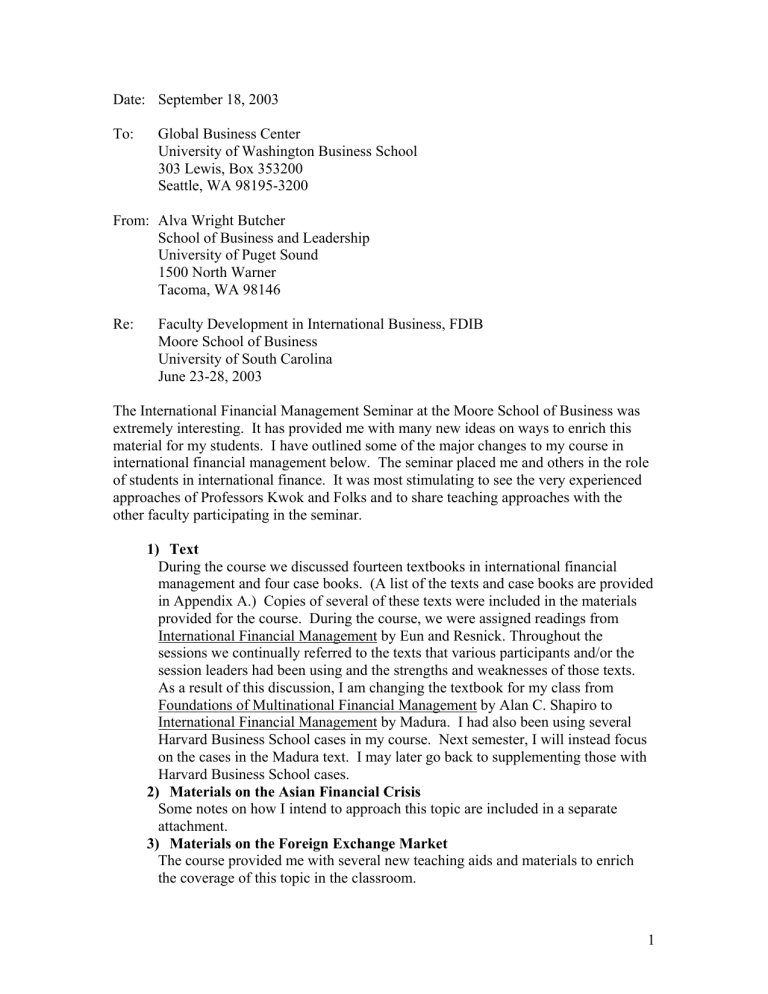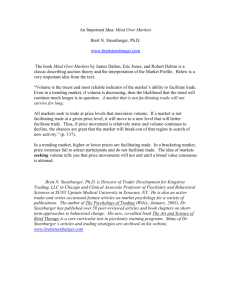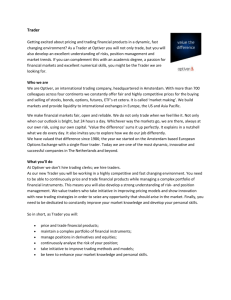Final Project

Date: September 18, 2003
To: Global Business Center
University of Washington Business School
303 Lewis, Box 353200
Seattle, WA 98195-3200
From: Alva Wright Butcher
School of Business and Leadership
University of Puget Sound
1500 North Warner
Tacoma, WA 98146
Re: Faculty Development in International Business, FDIB
Moore School of Business
University of South Carolina
June 23-28, 2003
The International Financial Management Seminar at the Moore School of Business was extremely interesting. It has provided me with many new ideas on ways to enrich this material for my students. I have outlined some of the major changes to my course in international financial management below. The seminar placed me and others in the role of students in international finance. It was most stimulating to see the very experienced approaches of Professors Kwok and Folks and to share teaching approaches with the other faculty participating in the seminar.
1) Text
During the course we discussed fourteen textbooks in international financial management and four case books. (A list of the texts and case books are provided in Appendix A.) Copies of several of these texts were included in the materials provided for the course. During the course, we were assigned readings from
International Financial Management by Eun and Resnick. Throughout the sessions we continually referred to the texts that various participants and/or the session leaders had been using and the strengths and weaknesses of those texts.
As a result of this discussion, I am changing the textbook for my class from
Foundations of Multinational Financial Management by Alan C. Shapiro to
International Financial Management by Madura. I had also been using several
Harvard Business School cases in my course. Next semester, I will instead focus on the cases in the Madura text. I may later go back to supplementing those with
Harvard Business School cases.
2) Materials on the Asian Financial Crisis
Some notes on how I intend to approach this topic are included in a separate attachment.
3) Materials on the Foreign Exchange Market
The course provided me with several new teaching aids and materials to enrich the coverage of this topic in the classroom.
1
Billion Dollar Day
This thirty minute video provides a very interesting glimpse of the foreign exchange market. Although this video is now out of print, I have located in through our library interchange program.
Foreign Exchange Simulation Game
We played this game in class, and
I think that it will be a very effective way of providing students with hands-on experience of dealing with bid/ask spreads in foreign exchange rates and in becoming more comfortable with the jargon used in foreign exchange markets. We will play this game in the classroom after we have watched foreign exchange trading on the above video. I have included an outline of the use of this simulation game in a separate attachment.
4) Emphasis on the Linkage between Finance and International Finance
A topic that I intend to add to the introductory sessions of my course is an overview of the main topics in finance and those in international finance. This is a very useful way to see the linkages as well as some topics that are unique to international finance. I have included an outline of notes for the first class in a separate attachment.
5) Emphasis on Recent Developments of the International Monetary System
I intend to Finance and Development, free articles published quarterly by the
IMF to stimulate student discussion on recent developments of the international monetary system. These are available at www.imf.org/external/pubind.htm
.
6 ) Example of a Cross-Border Equity Issue
This example was provided by Professor Folks and is based on information drawn from International Equity Markets: The Art of the Deal by Robert Lilja.
I am mailing a hard copy of these materials. I do not have them in digital form.
I would like to thank NIBEN for providing financial support that allowed me to participate in this seminar. I am sending the invoice with receipts via mail.
1
Billion Dollar Day, Enterprise Series, MTI Film and Video, 420 Academy Drive, Northbrook, Illinois
2
60062.
Butler, Kirt and Kwok, Chuch C.Y., “A Classroom Exercise to Simulate the Foreign Exchange Market,”
Journal of Teaching in International Business, Vol. 6, No.2, 1994, pp.59-73.
2
Appendix A
Choice of Textbooks in International Financial Management
Butler, Kirt C., Multinational Finance, Cincinnati, Ohio: South-Western College
Publishing, International Thomson Publishing.
Eiteman, D., A. Stonehill and M. Moffett, Multinational Business Finance, Reading,
Massachusetts: Addison-Wesley.
Eun, Cheol S. and Bruce G. Resnick, International Financial Management, Boston, MA:
Irwin/McGraw Hill.
Madura, Jeff, International Financial Management, Cincinnati, Ohio: South-Western
College Publishing, International Thomson Publishing.
Sercu, Piet and Raman Uppal, International Financial Markets and the Firm, Cincinnati,
Ohio: South-West College Publishing
Shapiro, Alan, Foundations of Multinational Financial Management, Boston: Allyn and
Bacon.
Shapiro, Alan, Multinational Financial Management, New York: John Wiley & Sons.
Other International Financial Textbooks
Baille, R. & P. McMahon, The Foreign Exchange Market: Theory and Econometric
Evidence, New York: Cambridge U. Press, 1989 .
Giddy, Ian H., Global Financial Markets, Lexington, MA: Heath
Grabbe, Orlin, International Financial Markets, Englewood Cliffs, New Jersey: Prentice
Hall.
Levich, Richard M., International Financial Markets: Prices and Policies, Boston, MA:
Irwin/McGraw Hill.
Scott, H. and P. Wellons, International Finance: Transactions, Policy, and Regulation, 2 nd
Edition, Westbury, New York: Foundation Press, 1995.
Solnik, Brunao, International Investments, Reading, MA: Addison-Wesley.
Tucker, A., J. Madura and T. Chiang, International Financial Markets, St. Paul: West
Publishing Company.
3
Case Books
Eaker, M.F. Fabozzi, and D. Grant, International Corporate Finance, Fort Worth Texas:
Dryden Press.
Kester, C. and T. Luehrman, Case Problems in International Finance, New York:
McGraw Hill (Harvard Business School Cases)
Moffett, Michael, Cases in International Finance, Reading, MA: Addison-Wesley.
Walter, Ingo and Roy Smith, Global Capital Markets and Banking, London: McGraw-
Hill
4
Foreign Exchange Simulation Game
Readings:
Madura, Jeff, International Financial Management 7 th
Edition, Chapter 3: International
Financial Markets
Supplementary Materials:
Billion Dollar Day
This thirty minute video provides a very interesting glimpse of the foreign exchange market. Although this video is now out of print, I have located in through our library interchange program.
Foreign Exchange Simulation Game:
Objectives
•
Learn how to use the bid and offer rates in trading currency
•
Learn how current events impact exchange rates
•
Experience the market psychology and explore trading strategies
Bank Members
The class will be divided into teams representing different banks. Each team will identify itself with the name of a bank. Some teams may adopt the names of major banks such as
Bank of America. Others may decide on more quixotic names. Each bank will have three members performing the functions of desk trader, floor trader, and position clerk.
•
Desk Trader -The desk trader is responsible for making a market in foreign currency and must quote bid and offer prices to anyone inquiring of the bank.
•
Floor Trader - This individual will shop around the room to determine the bid and offer quotes being offered by the various banks. The floor trader is attempting to
“buy low and sell high.” This individual has more flexibility than the desk traders in that he/she need not quote bid and offer prices. Instead floor traders shop around the various banks in an attempt to find price differences that would lead to arbitrage profits.
•
Position Clerk- The position clerk’s responsibility is to record the transactions.
This individual must also keep track of the bank’s net foreign exchange balance.
Banks try to keep long and short positions in a foreign currency in balance. Thus the position clerk will work with the desk trader to set bid and offer rates according to the prevailing market conditions.
1
Funds were provided for the development of these materials by CIBER at the University of Washington
Global Business Center under a grant from the U.S. Department of Education.
2
Billion Dollar Day, Enterprise Series, MTI Film and Video, 420 Academy Drive, Northbrook, Illinois
60062.
Foreign Exchange Simulation Game 1
Trading Rules
•
The game will be restricted to two currencies, e.g. the U.S. dollar and the
Japanese yen.
•
For most currencies, direct quotes will be used, e.g. $1.1823 per Euro. In the case of the Yen, it is easier to use indirect quotes because of the level of the exchange rate.
•
The contract size is standardized to one million, e.g. one million Yen. Trades can be between one and five contracts. This simplifies record keeping.
•
The bid-ask spread must be kept within ten points. E.G. 120.22¥ - 120.31¥ per dollar.
•
Banks may short sell.
•
Trading tickets are used by the floor traders and the desk traders to record transactions. Floor traders must get a trading ticket signed for each transaction and must return the trading ticket to the position clerk of his/her bank.
•
At the opening bell, the opening spot rate of exchange is announced. Then a news announcement is made. The following has just arrived over the wire: “The government of Japan has just announced that it will co-operate with the U.S.
Federal Reserve and buy dollars in an effort to stabilize the value of the dollar.”
The news announcement will encourage the students to question the impact of this news on the equilibrium exchange rate.
•
After a few trades have been consummated the instructor can shock the market with another news announcement. This not only leads the students to evaluate the impact of the news on the exchange rate, but it also provides each bank with the incentive to calculate its net foreign exchange exposure and plot strategy for the next round of trading.
•
During a thirty minute trading session, three to four news announcements liven up the game and lead to an interesting post-game analysis
•
At the end of the trading game, a final news announcement is made and the market spot rate is announced. Each bank must calculate its net gain or loss. In the post-game discussion, students can share trading strategies and discuss the impact of current events on foreign exchange rates.
Foreign Exchange Simulation Game 2
Example of Trading Tickets
Bank ___
$
Bank___
%
___
Bought ____$1M__________ Bought:______¥ 120.20____
Sold:______¥ 120.20_________ Sold _______$1M______
Deal with: Bank____A_____ Deal with Bank _____B______
Bid-Ask Spread: 120.10-120.20
Foreign Exchange Simulation Game 3
Notes for Opening Lecture
Increasing Importance of International Finance
•
Foreign exchange rates are becoming more volatile o Go to the web and demonstrate graphs of exchange rate movements o Ask students to do some research on the issue of the revaluation of the
Chinese Yuan.
•
Financial markets around the world are getting more integrated o Backup with articles from the Wall Street Journal and Financial Times
•
Multinational corporations are playing a more important role in the world economy.
Topics in Principles of Finance and International Finance
Main Topics in Principles of Finance
•
NPV and Capital Budgeting
•
Pricing of Financial Assets: Stocks and Bonds
•
Cost of Capital and Optimal Capital Structure
•
Working Capital Management
•
Dividend Policy
•
Merger and Acquisitions
•
Key Issues
Valuation of assets of different risk nature
Business and economic risk
Main Topics in International Finance
•
Multinational Capital Budgeting
In international finance we look at the value of the project from two perspectives, that of the parent and that of the subsidiary.
•
Pricing of International Finance Assets
e.g. Bankers Acceptance
Forward foreign exchange contract
•
Cost of Capital and Optimal Structure for Multinational Corporations
•
International Working Capital Management
•
Dividend Policy of Subsidiaries and Parent
•
International Mergers and Acquisitions
•
Key Issues
Other types of risk
Other international topics
•
Euromarkets
•
Market Segmentation
1
Funds were provided for the development of these materials by CIBER at the University of Washington
Global Business Center under a grant from the U.S. Department of Education.
Notes for first lecture 1
Topics Unique to International Finance
•
Foreign Exchange Risk
•
Parity Conditions
•
Political Risk
•
Euromarket
Notes for first lecture 2
The Asian Financial Crisis
Readings:
•
Madura, International Financial Management, 7 th
Edition , Appendix 6:
Government Intervention during the Asian Crisis
•
Yergin, Daniel and Stanislaw, Joseph, The Commanding Heights, Simon and
Schuster, Chapter 6: “Beyond the Miracle, Asia’s Emergence”, pp 157-193.
Supplementary Materials: Video Commanding Heights
•
Chapter 11: Global Contagion (7:55 minutes)
•
Chapter 12: Contagion Engulfs Asia (7:13 minutes)
•
Chapter 13: Russia Defaults (2:31 minutes)
•
Chapter 14: The Crisis Reaches America (7:07 minutes)
Discussion Questions
The class will be segmented into small groups. Each group is asked to assess all of the issues and determine a response. For each issue, one of the groups will be randomly selected and asked to present their solution. Then other students not in that group may suggest alternative answers if they feel the explanation can be improved. Some of the issues have no perfect solution, which allows for different points of view to be presented by students.
•
Why do you think the Indonesian rupiah was more exposed to an abrupt decline in value than the Japanese yen during the Asian crisis (even if their economies experienced the same degree of weakness)?
•
During the Asian crisis, direct intervention did not prevent depreciation of currencies. Offer your explanations for why the interventions did not work.
•
The Asian crisis showed that a currency crisis could affect interest rates. Why did the crisis put upward pressure on interest rates in Asian countries? Why did it put downward pressure on U.S. interest rates?
•
On August 26, 1998, the day that Russia decided to let the ruble float freely, the ruble declined by about 50%. On the following day, called “Bloody Thursday,” stock markets around the world, (including the United States), declined by more that 4 percent. Why do you think the decline in the ruble had such a global impact on stock prices? Was the market’s reaction rational? Would the effect have been different if the ruble’s plunge had occurred in an earlier time period, such as four years earlier? Why?
1
Funds were provided for the development of these materials by CIBER at the University of Washington
Global Business Center under a grant from the U.S. Department of Education.
Asian Financial Crisis 1
•
Normally, a weak local currency is expected to stimulate the local economy. Yet, it appeared that the weak currencies of Asia adversely affected their economies.
Why didn’t their economies initially improve because of the weakening of the currencies during the Asian crisis?
•
Why did the depreciation of the Asian currencies adversely affect the U.S. firms?
What were the types of exposures to exchange rate risk for some U.S. firms?
Asian Financial Crisis 2





